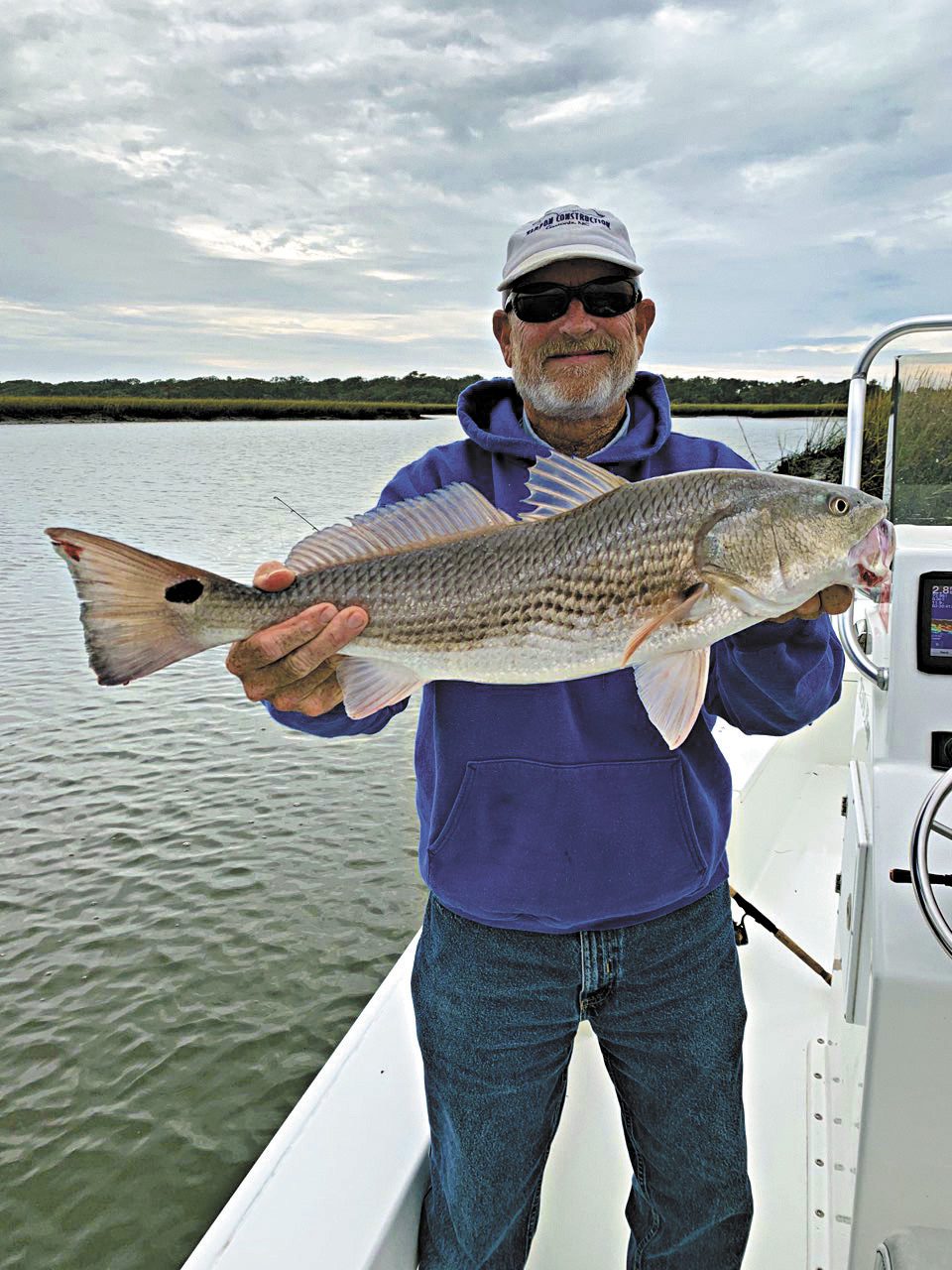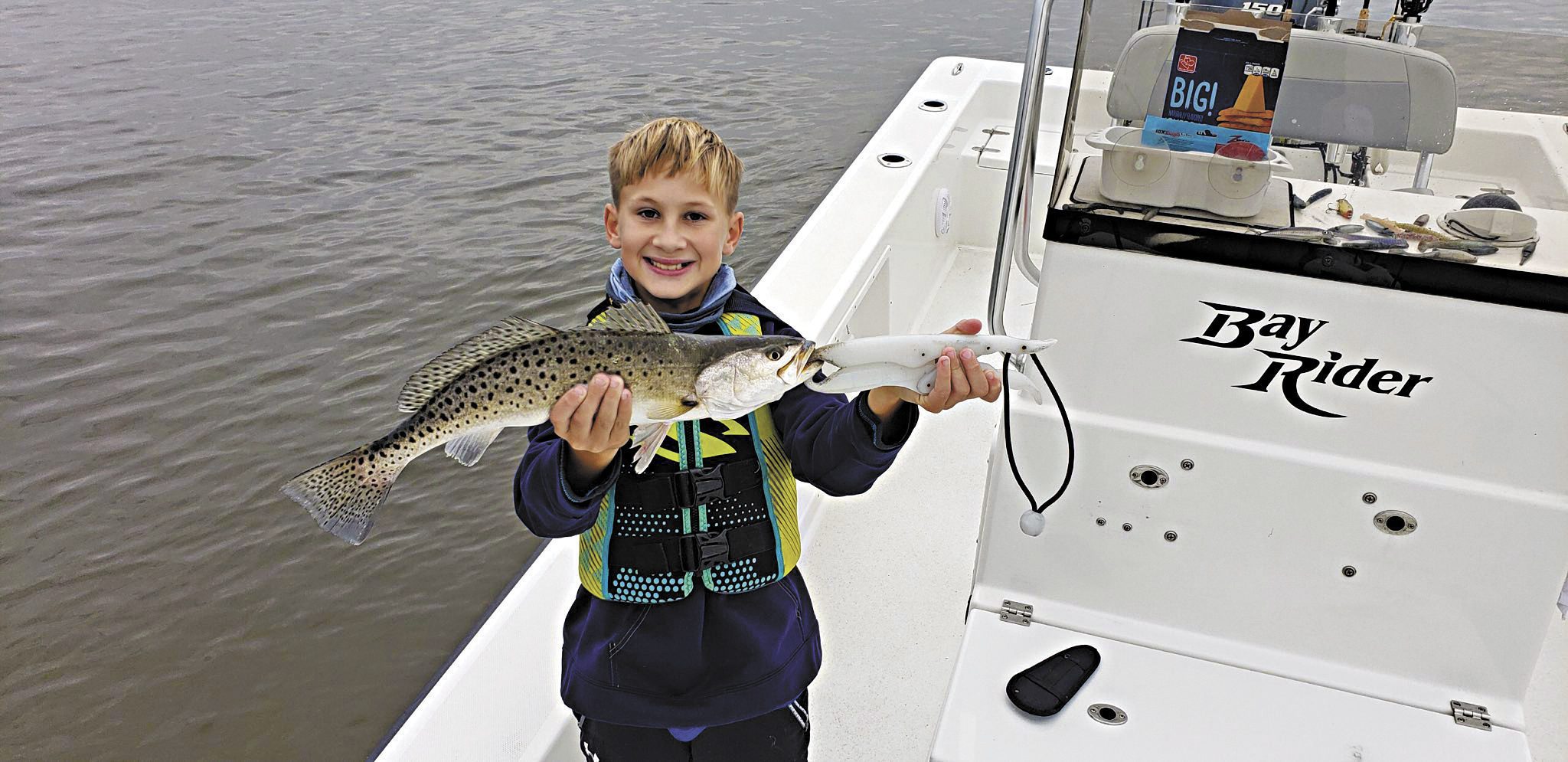Carolina Beach – Winter 2019-2020
Redd, of Island Tackle and Hardware, reports that speckled trout are holding from the inlet all the way back into the creeks of the Cape Fear River. Anglers in the feeder creeks working marsh edges in 4-6′ of water are having the most success. Casting MirrOlure MR17s in chicken-on-a-chain color and in the broken glass pattern have worked best. Other colors doing well are the all-white and red head/white body MR17s.
Redfish are also being spotted in creeks and near docks with around 6’ of water. Soft plastics, like new penny Gulp shrimp, are finding the reds.
Another key to finding both redfish and trout is locating the bait. Mud minnows, especially this time of year, are the main diet of both species.
There are still a few sheepshead and black drum being landed around bridges. Both are willing to chew on live or cut shrimp on a Carolina rig.
Nearshore, anglers are running into some smaller groups of bull redfish hanging around the local ARs. Large chunks of cut menhaden or mullet fished on the bottom have been the key to success.
Schools of gray trout holding on local ARs have been willing to bite on Stingsilver jigs.
King mackerel are off the beach in good numbers around the 10 mile mark. Drone spoons have been the go-to lure.
Out at the Gulf Stream, blackfin tuna, wahoo, sailfish, and a few peanut mahi are still hanging around.
Moving into the rest of the winter, the focus should be on wahoo and blackfin tuna. Wahoo will be at the Stream through March, and pulling large Ilander lures, Pirate plugs, and Yo-Zuri plugs (bonita color) will work best. Blackfin tuna will prefer the smaller Ilanders and Zuker’s feathers. Both species are hard pressed to turn down these rigs matched with ballyhoo.
In the next couple months, expect the nearshore bottomfish bite to remain strong. Black sea bass will be the main focus in the 10 mile range. They love cut cigar minnows fished close to structure.
Taugtogs will move into the same areas as the black sea bass. Some ‘togs will come in as far as the jetties (and even inshore around the bridges). Small pieces of cut shrimp will tempt these tasty fish to feed.

Ben Bumgarner with an over-slot red drum caught near Bald Head Island while fishing with Capt. Christian Wolfe, of Seahawk Inshore Fishing Charters.
Christian, of Seahawk Inshore Fishing Charters, reports that small red drum have been plentiful. Most of the reds are in the 16-17” range, with an occasional slot fish mixed in. Scented artificial baits have been producing the most fish, especially Gulp 3” shrimp. Some larger reds have been schooled up on the shallow flats when conditions are right.
Speckled trout have been hit and miss. Live shrimp and scented soft plastics have worked best, and creek mouths on the falling tide have been the top areas to target. The schools have been either all small fish or all keeper fish, with the biggest fish weighing in around 3-4 lbs.
Into the winter, focus on the backs of creeks. Don’t overlook the small feeder creeks either, as they can produce some of the best days. Bends and drop-offs in these creeks are going to hold the fish. The fish suspend over black mud that heats up the water during sunny days, and then they move back into deeper holes when the sun isn’t out.
Luke, of Spot On Charters, reports that speckled trout, red drum, and black drum are all biting in the inshore waters. The trout are mainly coming off curly tail grubs on jig heads, and they will continue biting all through the winter. The reds will be in the deeper holes in the creeks as the water gets colder, and big spinner baits (like Redfish Magic) should be able to pull them out.

Jake Mungo with a speckled trout caught while fishing with his dad, Capt. Tommy Mungo, of Mungo Fishing Charters, in the lower Cape Fear River.
Luke, of Coastline Charters, reports that fishing has been all about the hot speckled trout bite, as the past few weeks have been a trout fishing frenzy. The specks have been feeding up and down the ICW creeks, as well as in the inlets. The best tactics have been fishing soft plastics, like Trout Tricks and Z-Man products, MirrOlure MR17s, and live shrimp. Focus on deep holes, oyster bars, grass banks, points, and underwater structures.
The red drum have started to school up in the backs of creeks and on docks. The reds will take an interest in many soft plastics, like Gulp shrimp and Z-Man products. Fresh shrimp, as well as cut baits, on a Carolina rig should produce throughout the winter.
Black drum are feeding well around boat docks and oyster bars. They are chewing on shrimp and crabs on a Carolina rig, though they will take soft plastic shrimp on a jig head as well.
As the water continues to cool, expect the red and black drum to remain schooled up on docks and in the backs of creeks. Both drum species will feed well on fresh shrimp up tight to structure.
The trout fishing should go on through the winter months, too, but the focus should be more on deep holes or boat basins. Downsizing the size of your baits and slowing down your retrieve are of primary importance for targeting the reds and trout going into the colder winter months.
Rod, of OnMyWay Charters, reports that the king mackerel bite is fantastic right now. Fish are biting in the 15-25 mile range, and they will continue to do so through December. A majority of these kings are good-eating size (10-20 lb. fish), and larger ones (up to 35+ lbs.) are mixed in. Look for 62-68 degree water, and start pulling cigar minnows on Blue Water Candy dead bait rigs. Slow trolling between 2-4 knots has produced the most bites.
Feeding right alongside the kings are large false albacore. They will stick around all winter in the same 65-70 degree water temps and fall for to the same tactics used for kings.
Bottom fishing is focused in the 15-25 mile range. Groupers, beeliners, triggerfish, and good-sized black sea bass are sticking to wrecks and live bottom in the area. Cut squid, sardines, cigar minnows, and even small strips of false albacore are all pulling up quality fish.
The Gulf Stream continues to produce wahoo, blackfin tuna, and sailfish. Starting on ledges and rocks in 160-270′ of water and then finding temperature breaks and zig-zagging that line will help locate the fish.
Bluefin tuna are back, and they love that 55-62 degree water. The bluefins can be found from the beach out to 10 miles.
